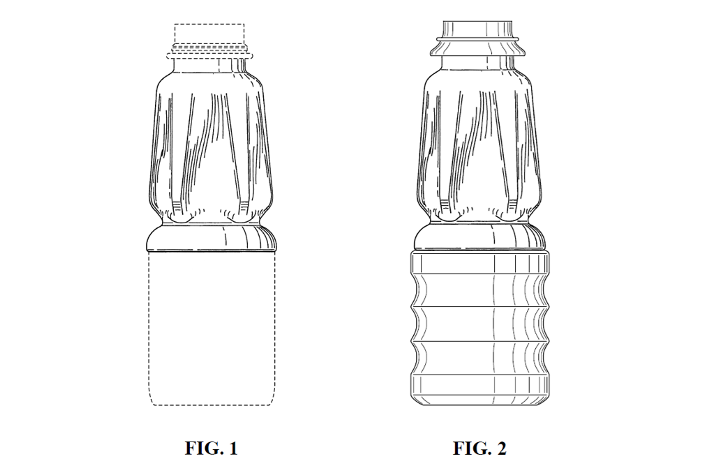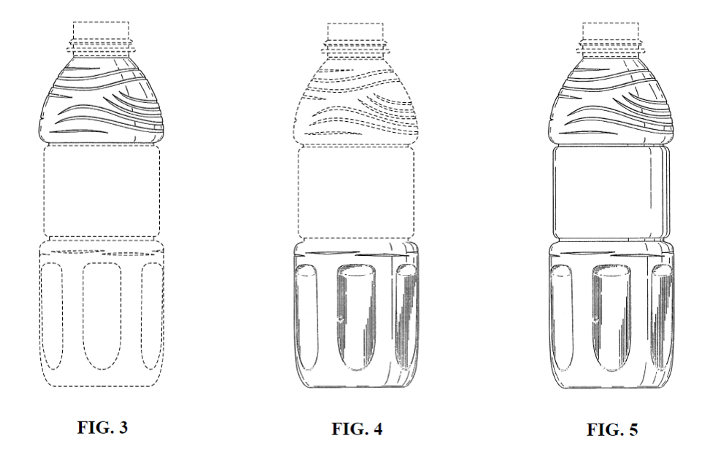Canadian industrial design practice requires the drawings included in an industrial design registration to show a complete finished article, capable of being made and sold separately. This means, for example, that if the article is a plastic molded part that is formed as a single unit, then the "complete finished article" is the entire plastic molded part. All of the drawings must show the entire plastic molded part, with some narrow exceptions.
It is important to appreciate that, although the drawings in the registration must show the entire article, the design protected need not be the appearance of the entire article. There are two ways of protecting a design that is not the appearance of the entire article. The first way is to include a description of the design that describes the portions of the article showing the design protected. The second way is to use different types of lines in the drawings to distinguish between the portions of the article that show the design and the portions that do not. The design portions are depicted in solid lines and the non-design portions are shown in stippled lines. The description of the design will include a statement that the portions of the article shown in stippled lines do not form part of the design. The second approach is a useful visual way of differentiating the design protected from the entire article.
The power of this approach to design registration is shown by comparing Figure 1 to Figure 2:

Assume that Figure 1 (taken from expired Canadian Industrial Design Registration No. 97253) is a registered design. Figure 1 shows a bottle with the neck and the bottom half in stippled lines. Only the top portion of the bottle is shown in solid lines. This means that the design is the top portion of the bottle. Suppose that a competitor makes the bottle shown in Figure 2. The bottle has a completely different neck and bottom half from Figure 1 but the same top portion. The differences do not matter because the design registration is not limited to a particular neck or bottom half. The design protected is the top portion of the bottle. The competitor's product is an exact copy of the registered design and would infringe the design of Figure 1.
Figures 3 to 5 (based on expired Canadian Industrial Design Registration No. 90545) show how protection may be enhanced by obtaining a number of registrations for the design of different parts of an article. In this case, again, the article is a bottle.

In all three figures, the neck of the bottle is shown in stippled lines to indicate that the design does not include the neck. In Figure 3, only the top one third of the bottle is shown in solid lines with the rest shown in stippled lines. Such
a registration would prevent a competitor from copying the top one-third of the bottle, irrespective of what the remainder of the competitor's bottle looks like. Figure 4 shows the bottom one-third of the bottle in solid lines with the rest shown
in stippled lines. Such a registration would prevent a competitor from copying the bottom one third of the bottle, irrespective of what the remainder of the competitor's bottle looks like. Figure 5 shows the bottle in solid lines except for the threaded
neck. Some may question whether there is any need for a registration of Figure 5 if there are registrations of Figures 3 and 4 since the features protected in Figures 3 and 4 appear to be the most distinctive features of the bottle. However, there
may be value in a separate registration of Figure 5 since the smooth centre one-third, which may not be sufficiently distinctive to register on its own, creates a distinctive visual impression in combination with the top one-third and the bottom one-third
of the bottle.
Figures 1 to 5 illustrate the importance of a careful review of the entire article to determine the design or designs to protect. Features that are new and important should be considered for registration, both separately, as in Figures 3 and 4, and in combination, as in Figure 5. This approach will help to ensure broad industrial design protection.
Our articles and newsletters are informational only, and do not constitute legal or professional advice. To obtain such advice, please communicate with our offices directly.
Related Publications & Articles
-
Not all that bubbles is Champagne – considerations for the protection of geographical indications in Canada
In this article, we outline the key considerations for foreign authorities and producers when seeking GI protection in Canada.Read More -
Canadian Intellectual Property Office “Next Generation Patents” update and status as of August 25, 2025
On July 17, 2024, CIPO launched a new electronic system and portal, MyCIPO Patents, as part of its Next Generation Patents initiative. The launch has been fraught with difficulties, creating delays, e...Read More -
Trends in patent filing for artificial intelligence-assisted medical technologies
Medical technologies incorporating artificial intelligence (AI) are an emerging area of innovation with the potential to transform healthcare. Employing techniques such as machine learning, deep learn...Read More
